Does a bone graft hurt while healing is a common question for those preparing for a bone graft procedure. This article aims to clarify the process and experience associated with dental bone grafting, providing information about various types, the necessary healing period, and tips for recovery. Understanding these aspects can alleviate fear and uncertainty, allowing for a more informed and confident approach to your dental treatment.
What Is a Dental Bone Graft?
A dental bone graft is a surgical procedure designed to rebuild and regenerate the bone in your jaw. This treatment becomes essential when the patient does not have enough bone to support dental implants or has experienced bone loss due to various issues such as tooth loss, gum disease, or trauma.
The process involves the use of grafting material to stimulate new bone growth. In this section, we will dive deeper into when a bone graft is needed, the types of graft materials, and how they work.
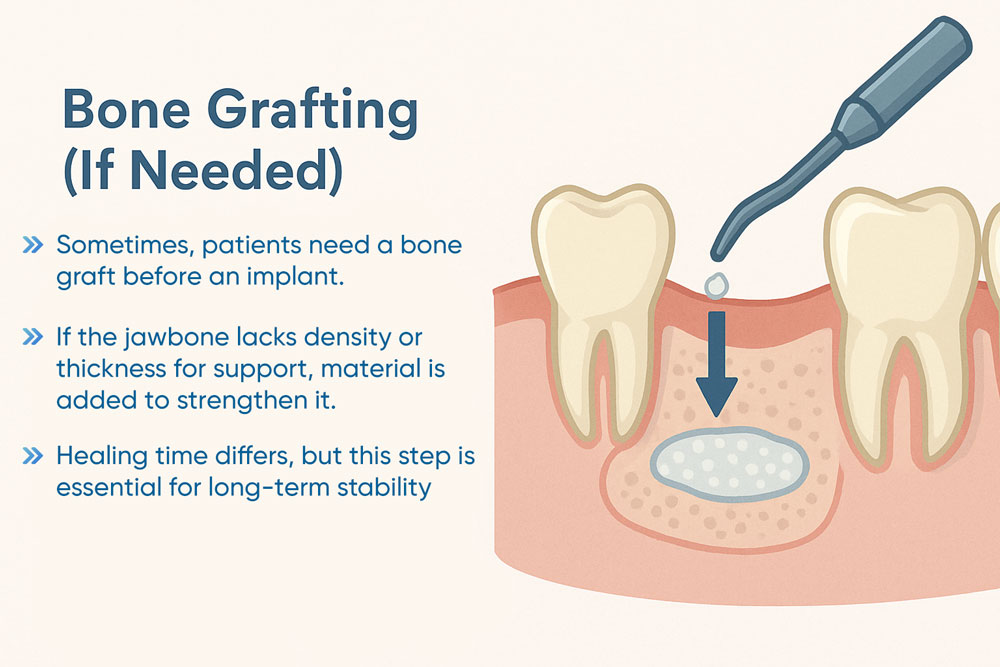
When Is a Bone Graft Needed?
A bone graft for dental implant is often required when the jawbone is too thin or soft to support an implant. There are several scenarios where this would be applicable:
- Pre-implant placement: Before inserting a dental implant, the dentist will assess the bone density and quality. If it is deemed insufficient, a bone graft may be recommended to enrich the area.
- Periodontal disease: Severe gum disease can lead to the loss of bone around the teeth, creating a need for bone grafting prior to other procedures.
- Trauma: Accidents that lead to significant damage to the jaw can compromise bone integrity, necessitating a bone graft.
Understanding the necessity for a bone graft may help patients better prepare for the healing process and the final outcome of their dental treatments.
Types of Graft Material
Various types of graft materials can be utilized to enhance bone growth during a Dental Bone Graft:
- Autograft: This involves taking bone from the patient’s own body, often from the hip or another site. Autografts tend to integrate well, minimizing the risk of rejection.
- Allograft: In this case, donor bone is used. The bone is harvested from a cadaver, processed, and treated to ensure safety and compatibility.
- Synthetic materials: Some procedures may use synthetic or ceramic materials to stimulate bone growth without the need for human tissue.
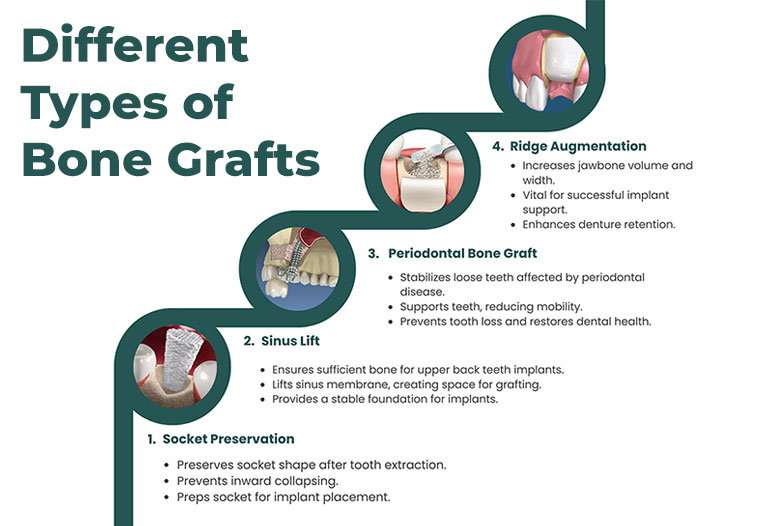
Each type of graft has its unique benefits and considerations. Patients should discuss with their dentist to determine the most suitable option based on their individual circumstances.
Bone Graft for Tooth Implant: Why It’s Necessary
Implementing a bone graft is not just about preparation; it’s crucial for successful long-term outcomes when placing a dental implant. Bone grafting serves several vital functions in relation to tooth implants.
Preparing the Jaw for Successful Implant Placement
One of the primary roles of a bone graft is to provide a stable and robust foundation for the dental implants. Proper bone density and shape are essential for:
- Supporting the implant securely
- Ensuring the longevity and stability of the implant
- Facilitate better chewing and functionality
Having inadequate bone volume can lead to implant failure, making the prospect of a successful bone graft critical for patients considering implants.
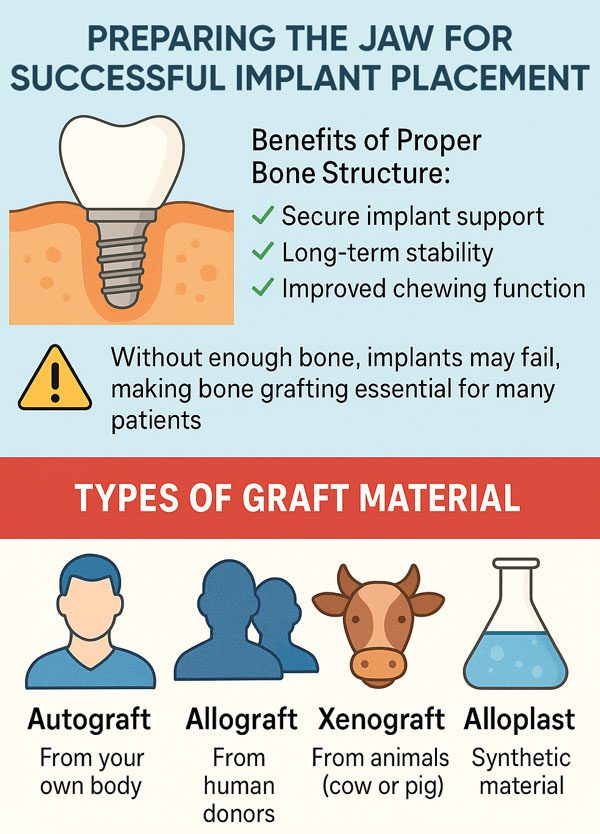
Preventing Implant Failure
Implants rely on the surrounding bone for support, functionality, and durability. Without sufficient bone, implants can fail for the following reasons:
- Insufficient support: The implant may become loose or shift over time, which can lead to further complications.
- Bone infection: Lack of density can create spaces for bacteria to proliferate, leading to infections that may jeopardize the success of the graft.
- Inadequate healing: If the graft fails to integrate, the resulting complications can mean additional surgeries and prolonged treatment times.
Knowing the importance of the bone graft for tooth implant can encourage patients to comply with preoperative instructions and postoperative care to secure their investment in their dental health.
Common in Patients with Bone Loss
Patients with a history of:
- Missing teeth
- Gum disease
- Trauma to the jaw
are more likely to require a bone graft before receiving implants. Bone loss is often a gradual process and may go unnoticed until a dental examination reveals its extent. Regular check-ups and early intervention can greatly assist in addressing these issues, providing patients with a better chance of retaining or restoring their dental health.
Does a Bone Graft Hurt While Healing?
Many patients express concerns about pain and discomfort associated with a bone graft. This section will discuss what to expect during the healing process and ways to manage any discomfort.
Immediate Post-Op Discomfort
After the procedure, it is common to experience mild to moderate discomfort. Here’s what you might anticipate after a bone graft:
- Pain management: Dentists will usually prescribe pain medication to alleviate discomfort. Over-the-counter options may also be effective for some individuals.
- Common sensations: Patients often report soreness, swelling, or bruising around the graft site, which generally peaks in the first few days after surgery.
By managing expectations regarding pain, patients can feel more in control of their recovery.
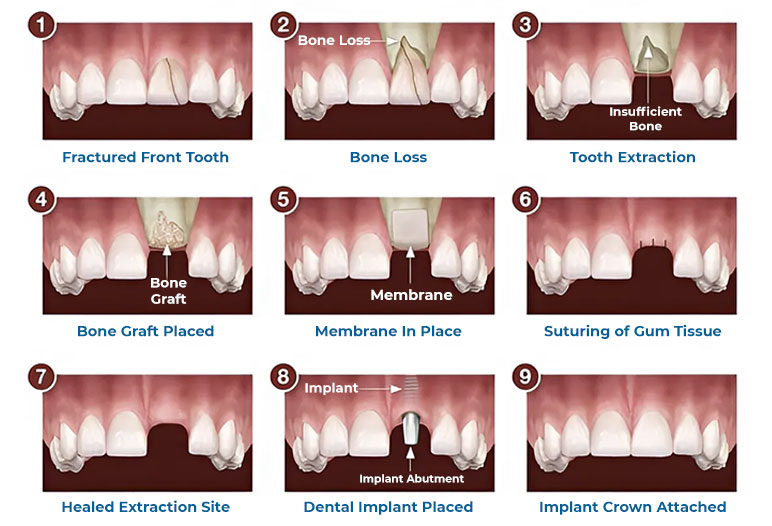
Typical Healing Sensations
Patients undergoing bone grafting should prepare for various sensations during the healing phase, including:
- Soreness: This may be a throbbing or dull ache that can be easily managed with medication.
- Swelling: This is a normal response to surgery and can vary in severity from person to person.
- Bruising: Some discoloration may develop, particularly if the surgical site was extensive.
These sensations are typically part of the body’s healing responses and should gradually subside as the healing progresses.
Complications and Warning Signs
While most patients experience only mild discomfort, it’s crucial to be aware of reliable indicators that something may be wrong. Sharp or severe pain, especially if it worsens over time or is accompanied by other symptoms such as:
- Increased swelling or redness
- Fever
- Pus or unusual discharge
- Excessive bleeding
indicates that you should contact your dentist immediately. Complications may include infection or issues such as a dry socket.
How Long Is the Healing Process After Bone Grafting?
Understanding the healing timeline is beneficial for setting patient expectations following a dental bone graft. This section outlines the healing process in detail.
Soft Tissue Healing
The body typically starts healing the soft tissues around the graft quite quickly, often within one to two weeks. Factors impacting this process include:
- Individual healing responses: Everyone’s body heals differently, so timing may vary.
- Adherence to post-operative care: Patients who follow instructions for care, pain management, and diet may experience an expedited recovery.
- Overall health and lifestyle: Health conditions such as diabetes can delay healing.
During this period, dentists will evaluate the healing progress at follow-up visits.
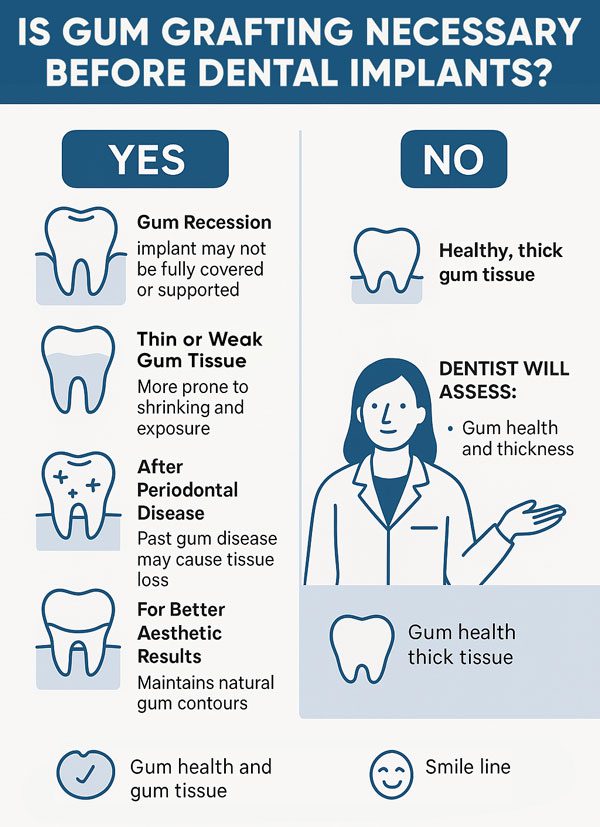
Bone Integration
While soft tissue may heal quickly, the integration of bone takes longer. Typically, patients can expect a healing period ranging from three to six months. This phase includes:
- Osseointegration: The bone graft gradually fuses with the surrounding jawbone. This new bone growth is crucial for the stability of future implants.
- Follow-up appointments: Regular check-ups allow the dentist to monitor healing and determine the optimal time to place the implant.
Bone integration is vital for the longevity and success of dental implants, making patience during this stage necessary.
Tips to Minimize Pain and Speed Up Recovery
Post-operative care plays a crucial role in reducing discomfort and expediting the recovery process. Here are some practical tips to ensure a comfortable healing experience.
Follow Your Dentist’s Instructions
Adhering to your dentist’s post-operative guidelines can help alleviate unnecessary pain and complications. These instructions may include:
- Taking prescribed medications for pain relief to stay ahead of discomfort.
- Avoiding certain activities, like strenuous exercise or heavy lifting, which could disrupt the healing process.
Being proactive in following advice will facilitate a smoother recovery journey.

Use Prescribed Painkillers or OTC Medications
Manage pain effectively by utilizing medications as directed:
- Prescribed medications should be taken as advised to control pain.
- Over-the-counter options like ibuprofen or acetaminophen may also provide relief. Always check with your dentist before taking any additional medications.
Apply Cold Compresses for Swelling
For managing swelling, applying a cold compress to the affected area for 20 minutes on and off during the first 48 hours can be very effective:
- Reduce swelling and numb discomfort in the area.
- Enhance blood flow, promoting better healing.
Always ensure you wrap ice packs in a cloth to prevent skin damage.
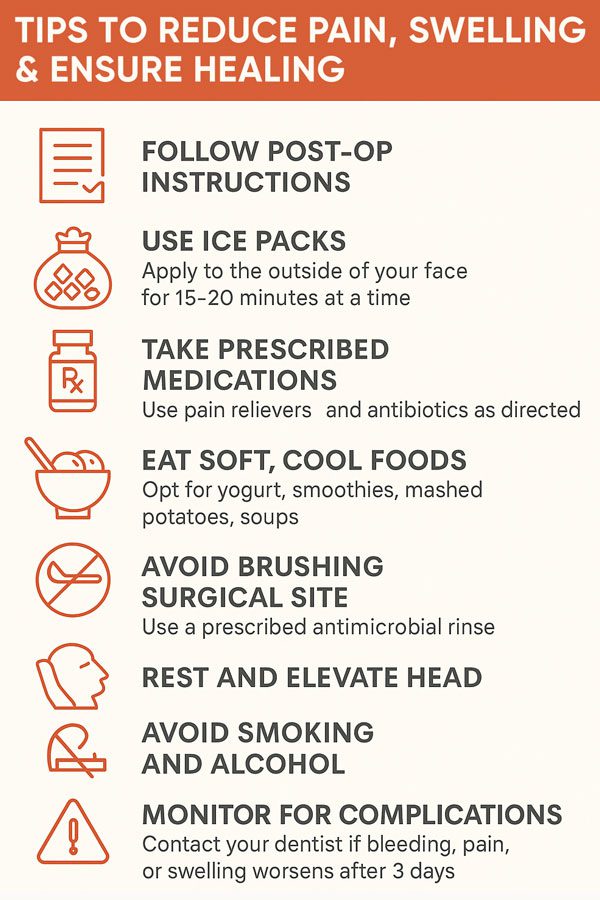
Eat Soft Foods and Maintain Oral Hygiene
Maintaining a healthy diet while being cautious about food selection is key:
- Soft foods are advisable in the days immediately following surgery to avoid irritation.
- Good oral hygiene is essential, but be gentle around the surgical site to avoid disturbing the graft.
Using a soft-bristle toothbrush can help care for your mouth without compromising the surgical area.
When to Contact Your Dentist
While some discomfort is normal, patients should remain vigilant for signs that signal the need for professional evaluation. Here are the main signs and symptoms to watch for:
Signs of Infection
Infection can significantly hinder the healing process and can be indicated by:
- Increasing pain that is not alleviated with medication.
- Fever or consistent warmth around the surgical site.
- Pus or unusual discharge from the area.
If you notice any of these symptoms, contact your dentist as soon as possible.
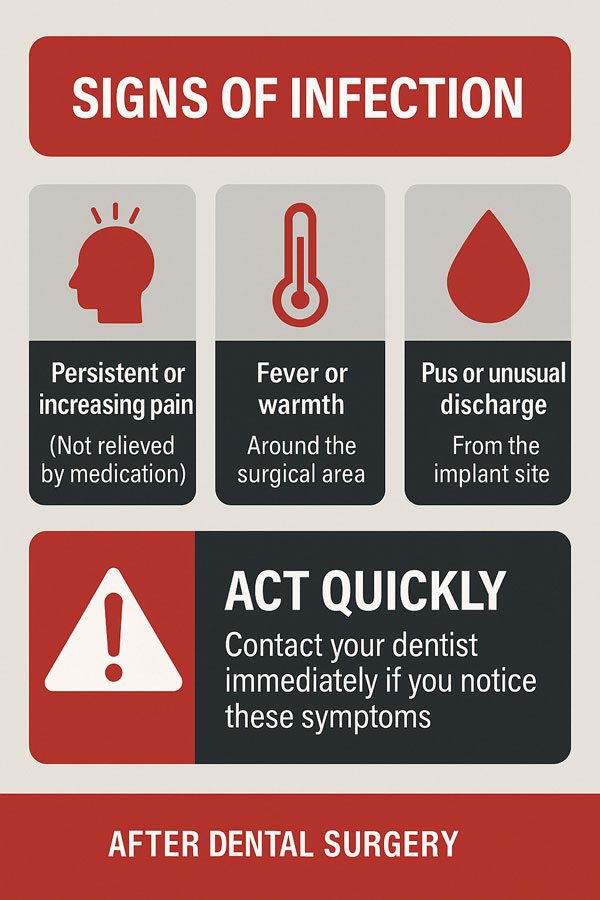
Loose or Extremely Painful Implant Site
Should the graft site feel loose or extremely painful after a few days, it is imperative to reach out to your dental professional. This may indicate a failure in the grafting process that requires immediate attention.
Follow-Up Visits for Monitoring
Regular follow-up appointments are crucial to ensure that healing is progressing well. Attending these visits allows your dentist:
- Assess the graft and healing accurately.
- Make necessary adjustments in your care if concerns arise.
Prevention is vital to a successful recovery, emphasizing the importance of communication with your dental provider.
Conclusion
In summary, while discomfort is a common experience during the healing process following a bone graft, it should not be intense or uncontrollable. Understanding the need for a bone graft, the types available, and the healing duration can help patients approach their treatment with confidence and clarity. Most patients report only mild to moderate soreness, manageable with proper care and pain relief strategies. If concerns regarding pain arise, reaching out to your dentist can provide further understanding and peace of mind as you navigate the recovery process effectively.

 Google Reviews
Google Reviews Call
Call
SAIGON IMPLANT CENTER
Best dentist in Vietnam
Saigon Implant Center - Dental Clinic utilizes the latest technology for specialized treatment in the field of Single implant, full jaw implants, All on 4 implants, All on 6 implants, Zygoma implant....
SAIGON IMPLANT CENTER
Best dentist in Vietnam
Saigon Implant Center - Dental Clinic utilizes the latest technology for specialized treatment in the field of Single implant, full jaw implants, All on 4 implants, All on 6 implants, Zygoma implant....